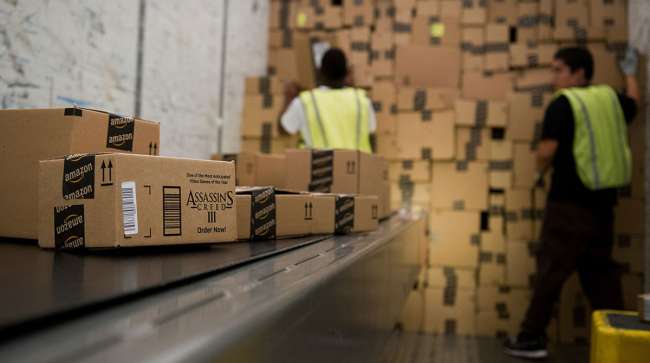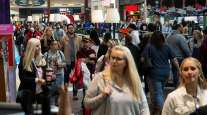Staff Reporter
Experts Foresee Strong Demand for Packaged Goods After COVID Subsides

[Stay on top of transportation news: Get TTNews in your inbox.]
Demand for consumer packaged goods jumped amid the coronavirus, but indications are it will remain elevated even after the pandemic eases.
The Consumer Brands Association (CBA) released a report March 11 that found consumer packaged goods purchases are expected to decelerate between 1% and 2% year-over-year in 2021. But the annual rate of purchases still is expected to grow by 7.4% to 8.5% compared with 2019.
“I think the ongoing demand to me breaks down into short-term and long-term behavior,” Katie Denis, vice president of industry narrative at the CBA, told Transport Topics. “In the short term, obviously, we’re still elevated because we’re still very much in the pandemic.”

Denis
Denis added that people are not just going to immediately run out to restaurants once vaccine distribution increases. Many will take a wait-and-see approach before resuming normal activities.
But changes in habits also could result in more long-term trends as well.
“From a long-term perspective, a lot of our behavioral patterns changed, and that’s going to elevate demand,” Denis said. “So when you think about the number of people who’ve got pets, I’m definitely one of them, or the people who bought coffee makers, things that became part of our pandemic norm will continue. I think the biggest example of that is certainly the work from home phenomenon.”
The CBA report found that 82% of those surveyed wanted to continue to work remotely, at least in some form, once a return to workplaces has been deemed safe. Denis noted such people are likely to continue to eat at home more often instead of ordering from a restaurant during their lunch break.

Terrazas
“I think that certainly aligns with our market outlook,” Aaron Terrazas, director of economic research at Convoy, told TT, “this idea that the behaviors that consumers acquired during the pandemic are going to stick around, even after things reopen and people get back to their normal lives.
“I certainly anticipate there will be more eating at home in the long term and more people living their lives in their private spaces rather than in the public sphere.”
Convoy customers are expecting that demand for their products will remain strong at least through 2021, Terrazas noted. He also said the economic data that he’s looked at supports the idea that demand will remain elevated such as consumer spending surveys that are at multi-year highs.

Fleets are investing in tech-based safety tools that inform and forewarn potential risk. But how do they condition and prepare drivers to respond to safety alerts? Find out as the RoadSigns Team speaks with Tom DiSalvi, VP of safety at Schneider National, and Charlie Mohn, director of product innovation at Drivewyze. Hear a snippet, above, and get the full program by going to RoadSigns.TTNews.com.
“The continued demand for products closely translates to continued demand for trucking capacity,” Tom Madrecki, vice president of supply chain and logistics at CBA, told TT. “There are people who are more and more reliant on e-commerce. Not just within the [consumer packaged goods] industries specifically, but writ large across the U.S. consumer base.”
John Bozec, senior vice president and general manager of the van truckload division at Schneider National, also sees elevated demand as a distinct possibility. He noted more people continuing to work from home across the economic landscape, and habits formed around cleaning and buying sanitary products could help drive the trend even after the pandemic eases.
“I think you are going to naturally then have the corresponding impact where that’s perhaps one less lunch eaten out at a cafe, perhaps one less coffee being purchased at a coffee shop,” Bozec told TT. “Rather, the consumer is going to make those products at home when they’re working at home. I think that will support the theory that consumer packaged goods demand will be up, or at least be maintained at an elevated level even after the pandemic starts to subside.”

Bozec
He added that the increased demand would mean more pressure on his business. Bozec noted that means investing to ensure orders are delivered on time and capacity is at an adequate level so that the customers’ needs are met.
“I think from our perspective, and this is really regardless of modes, whether it is truck or it’s intermodal or it’s logistics, should this trend really continue, it will put pressure on us and pressure that we embraced regardless of mode,” Bozec said. “As these elevated consumer demands might be out there, so is the pressure for on-time performance and capacity level to support it.”
Schneider ranks No. 5 on the Transport Topics Top 100 list of the largest for-hire carriers in North America.
Terrazas added that trucking should be able to handle the demand so long as manufacturers and retailers anticipate it and plan for their transportation needs. He noted the good thing is that many companies and associations are paying attention to this, but problems could arise.
“One is if the demand appears in places, communities or through distribution channels that have been dormant for much of the past year,” Terrazas said. “The second potential problem area I have my eye on is that with these great expectations for consumer spending, there’s going to be a great stress on our warehousing capacity and inventory.”
Want more news? Listen to today's daily briefing below or go here for more info:



